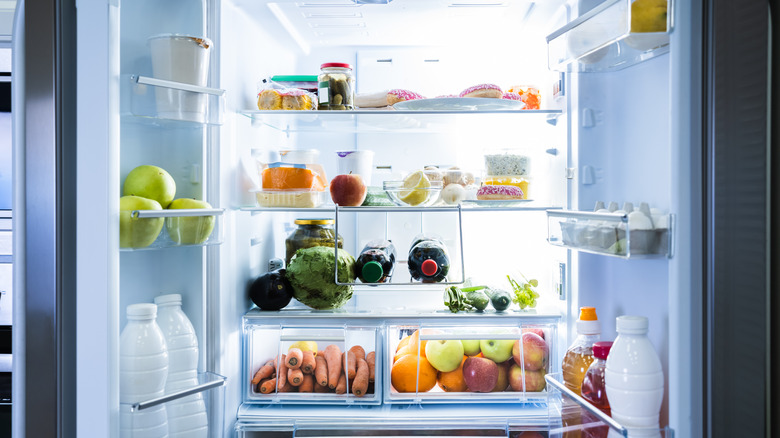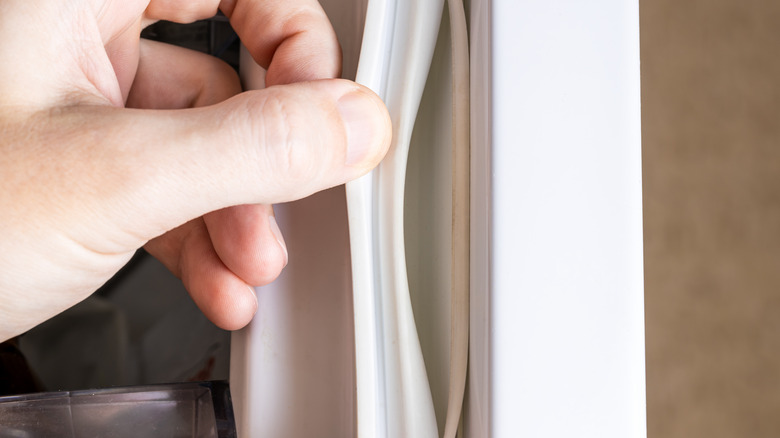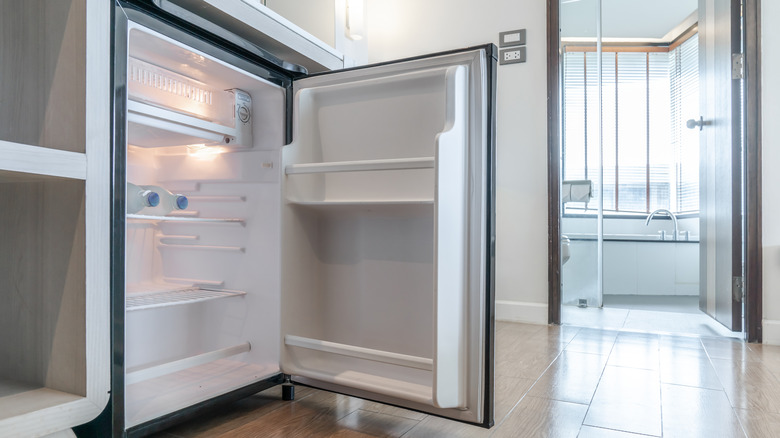The Fastest Fix For A Fridge Door That Won't Stay Closed
A fridge door that won't stay closed can spell disaster for your food, budget, electric bill, and even your health. And although there are many possible reasons for a balky fridge door, the most likely cause is simply an imperfect seal. This component can be compromised when the gasket ages and becomes hardened, brittle, or warped.
Even a small leak in your fridge can be problematic; cold air escapes, and the light that indicates an open door will produce additional heat inside of it, according to Dan-Marc Appliances. A door that is ajar will also cause frost to accumulate in the freezer. Additionally, food spoilage begins when temperatures exceed 40 degrees Fahrenheit, and food-borne illness becomes a possibility when the door won't stay closed. Furthermore, a refrigerator's worth of ruined food can cost an average of $160, as reported by the Baltimore Sun.
More often than not, the fastest fix for this problem involves cleaning and lubricating the gasket responsible for maintaining suction between the door and appliance body. Here's how to do both.
Lubricating and cleaning the gasket
If it is unclear whether the refrigerator is completely sealed, try this, as noted by K & J Magnetics: Open, then close the door on a dollar bill placed between the gasket and the fridge's chassis. If the seal is adequate, there will be resistance.
Dirt, grime, mold, and food particles will interfere with a complete seal. Fortunately, thoroughly wiping the gasket and fridge door frame with warm water and a bit of baking soda will improve the suction. Mild dish soap or a touch of white vinegar can be added to bolster the cleanser. Make sure to reach all visible surfaces (don't ignore the inside of the gasket), then completely dry it afterwards. According to K & J Magnetics, the gasket itself can also be removed and soaked in the warm solution to clean it and make it more pliant. Homeowners have even been known to dry it later using a hair dryer.
For step two, Home Repair Geek suggests performing a lube job on the gasket with a thin layer of petroleum jelly. The lubricant can be applied with a cloth, cotton swab, or finger; note that silicone grease can also be used instead of the jelly. Either substance will then strengthen the seal by softening the gasket. Dan-Marc Appliances further asserts these lubricants enhance the connection by making the gasket springier and gummier. They can also be used to treat a replacement before installing it.
Repairing or replacing the gasket and other fixes
If cleaning and lubricating the gasket doesn't work, you may have to repair or replace it. If there is a break in the gasket, it can be mended with silicone sealant covered with wax paper. After making the fix, Appliance Express recommends closing the door and allowing eight hours for it to set. If a replacement is necessary, your can buy a new gasket strip — just note that it needs to be compatible with the refrigerator brand and model, or switched for a universal one.
Although it sounds daunting, a DIY gasket replacement is also possible. Per Flamingo Appliance, a new one can be had for considerably less than $100 and installed in a half hour. The old gasket can be unscrewed and removed, then the new one snapped in. Adhesive tape or specialized cement will solidify the bond.
Other culprits for a fridge door that won't stay closed might be faulty hinges that need to replaced, or the actual appliance may be tilted and require an adjustment of the foot screws. It's also possible that a magnetized door may have lost its attraction and a repair service will have to be summoned. Replacing a damaged door is an option, and a new refrigerator is a last resort.


